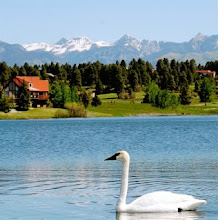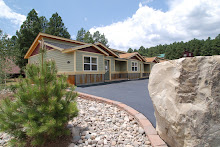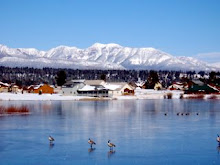I pulled out of San Francisco with a U-haul truck and trailer for the last time in June 2006. Made it to Pagosa Springs for good a few days and exactly 1200 miles later.
I lived much of my years in a southern portion of The City called Noe Valley. In the mid-1800's, a fellow of Mexican descent starting farming the valley. And, yes, his last name was Noe. By the end of World War II, the hills and flats of Noe Valley became populated by modest small houses and blue collar baby boom families. By the 1980's, Noe Valley's housing stock and population had begun to age.
Of course, what I'm going to get to here, eventually, is the parallels between the Noe Valley of San Francisco, California and Pagosa Springs, Colorado. A lot of things in this world, I'm not so good at. But I like to think that I have some expertise in the area of "stop, look and listen".
Sitting in front of a by-the-minute computer terminal on Market Street in the heart of the Castro District -- yes, that Castro District -- I am both pleased to be back in The City and thrilled to be leaving again. In the 1960's, places like the Castro District and the Haight-Ashbury area contained older poorly-maintained victorian buildings with an aging population. The Castro district saw an influx of new money and renovation in the 1970's.
Over the steep hill of Castro Street heading south, Noe Valley's new dawn began in the late 1980's. While the Castro District has always had large quantities of historical victorian buildings to boast, overall, Noe Valley had a more modest, inexpensive post-WWII box-like architectural quality.
In the 1990's, in particular, young new families were looking for a cheaper part of The City to call their own. A place with houses that could be improved as their financial situation matured. A place where other young families would begin to congregate around a commercial hub like 24th Street a few blocks walk away. A place that increasingly enjoyed hip new restaurants, a little night life and the overall feel of an upwardly-mobile young white new generation.
By the beginning of the new millenium, the young upwardly mobiles (remember the term "yuppies") had begun to take over Noe Valley and, increasingly, the forces of economics have driven the older remaining population away. The older fixed-income seniors were unable to afford properly maintaining their older houses, and the new population was more than willing to fix up or tear down and build up modern housing in their place. Increasingly, baby strollers, expensive cars, visitors and expensive houses came to dominate Noe Valley; all in about a fifteen year time frame.
Downtown Pagosa Springs can, perhaps, breathe a sigh of relief because there is no economic engine driving the "X generation", "Y generation", "yuppies" (or whatever they are called now) to take over downtown Pagosa Springs. The forces of "no growth" and "keep Pagosa Pagosa" can, for a brief moment, believe that the "river of change" doesn't apply to our little Town and that, somehow, things can just stay the same.
In our Town, the only way that an influx of young, new families will make Pagosa Springs their new home is if we consciously and intentionally invite them in. Otherwise, they will not be coming.
But, here is the bad news. Young, upwardly mobile families are only one class of "People with Money". Like I said, I'm sitting here in the heart of the San Francisco Castro District. There are a whole lot of "People with Money" walking around and expensive cars driving by but almost no baby strollers.
Without any evidence other than my so-called "stop, look and listen" skills, I am going to make a bold assertion here. The weak hands of older Pagosa residents is getting shaken loose right now. People are loosing jobs. Fixed income seniors are going to find it increasingly difficult to maintain their lifestyle in our little "resort" town, and new young families will find better opportunity elsewhere.
Much to the chagrine of the "keep Pagosa Pagosa" people, that is not the end of the story. There are economic forces that will continue to drive the "weak hands" Pagosa landholders to sell to the stronger hands of a new class of "People with Money". For lack of a better word, the economic forces could be called "gentrification". But it might be more to the point to say that we here in Pagosa Springs have what some "People with Money" want. It is the simple force of economics.
Sometimes those forces cause a place to decay. But in a case like Pagosa Springs, take a look at the entire Colorado Western Slope and you will see what is about to happen here next.
So, this is my big question. If the economic forces of gentrification don't drive new, young families to buy up downtown Pagosa Springs over, say, the next 20 years......then exactly who are my predicted "People with Money" who will buy up Pagosa Springs? That, I think, is a question worth examining by those of us with an interest in the future of downtown.
The second question that is dear to my heart is this: what can we do, now, to attract new young upwardly mobile families and have them be a large part of this new influx of "People with Money"?
This is the first time in the San Francisco Bay Area in over two years. Seems like I know every square inch and still have lots of friends. Needless to say, the thing that has changed the most is me. Change is the one constant. Like our San Juan River, it might look like a permanent "thing" but it is always never the same.
I lived much of my years in a southern portion of The City called Noe Valley. In the mid-1800's, a fellow of Mexican descent starting farming the valley. And, yes, his last name was Noe. By the end of World War II, the hills and flats of Noe Valley became populated by modest small houses and blue collar baby boom families. By the 1980's, Noe Valley's housing stock and population had begun to age.
Of course, what I'm going to get to here, eventually, is the parallels between the Noe Valley of San Francisco, California and Pagosa Springs, Colorado. A lot of things in this world, I'm not so good at. But I like to think that I have some expertise in the area of "stop, look and listen".
Sitting in front of a by-the-minute computer terminal on Market Street in the heart of the Castro District -- yes, that Castro District -- I am both pleased to be back in The City and thrilled to be leaving again. In the 1960's, places like the Castro District and the Haight-Ashbury area contained older poorly-maintained victorian buildings with an aging population. The Castro district saw an influx of new money and renovation in the 1970's.
Over the steep hill of Castro Street heading south, Noe Valley's new dawn began in the late 1980's. While the Castro District has always had large quantities of historical victorian buildings to boast, overall, Noe Valley had a more modest, inexpensive post-WWII box-like architectural quality.
In the 1990's, in particular, young new families were looking for a cheaper part of The City to call their own. A place with houses that could be improved as their financial situation matured. A place where other young families would begin to congregate around a commercial hub like 24th Street a few blocks walk away. A place that increasingly enjoyed hip new restaurants, a little night life and the overall feel of an upwardly-mobile young white new generation.
By the beginning of the new millenium, the young upwardly mobiles (remember the term "yuppies") had begun to take over Noe Valley and, increasingly, the forces of economics have driven the older remaining population away. The older fixed-income seniors were unable to afford properly maintaining their older houses, and the new population was more than willing to fix up or tear down and build up modern housing in their place. Increasingly, baby strollers, expensive cars, visitors and expensive houses came to dominate Noe Valley; all in about a fifteen year time frame.
Downtown Pagosa Springs can, perhaps, breathe a sigh of relief because there is no economic engine driving the "X generation", "Y generation", "yuppies" (or whatever they are called now) to take over downtown Pagosa Springs. The forces of "no growth" and "keep Pagosa Pagosa" can, for a brief moment, believe that the "river of change" doesn't apply to our little Town and that, somehow, things can just stay the same.
In our Town, the only way that an influx of young, new families will make Pagosa Springs their new home is if we consciously and intentionally invite them in. Otherwise, they will not be coming.
But, here is the bad news. Young, upwardly mobile families are only one class of "People with Money". Like I said, I'm sitting here in the heart of the San Francisco Castro District. There are a whole lot of "People with Money" walking around and expensive cars driving by but almost no baby strollers.
Without any evidence other than my so-called "stop, look and listen" skills, I am going to make a bold assertion here. The weak hands of older Pagosa residents is getting shaken loose right now. People are loosing jobs. Fixed income seniors are going to find it increasingly difficult to maintain their lifestyle in our little "resort" town, and new young families will find better opportunity elsewhere.
Much to the chagrine of the "keep Pagosa Pagosa" people, that is not the end of the story. There are economic forces that will continue to drive the "weak hands" Pagosa landholders to sell to the stronger hands of a new class of "People with Money". For lack of a better word, the economic forces could be called "gentrification". But it might be more to the point to say that we here in Pagosa Springs have what some "People with Money" want. It is the simple force of economics.
Sometimes those forces cause a place to decay. But in a case like Pagosa Springs, take a look at the entire Colorado Western Slope and you will see what is about to happen here next.
So, this is my big question. If the economic forces of gentrification don't drive new, young families to buy up downtown Pagosa Springs over, say, the next 20 years......then exactly who are my predicted "People with Money" who will buy up Pagosa Springs? That, I think, is a question worth examining by those of us with an interest in the future of downtown.
The second question that is dear to my heart is this: what can we do, now, to attract new young upwardly mobile families and have them be a large part of this new influx of "People with Money"?







No comments:
Post a Comment